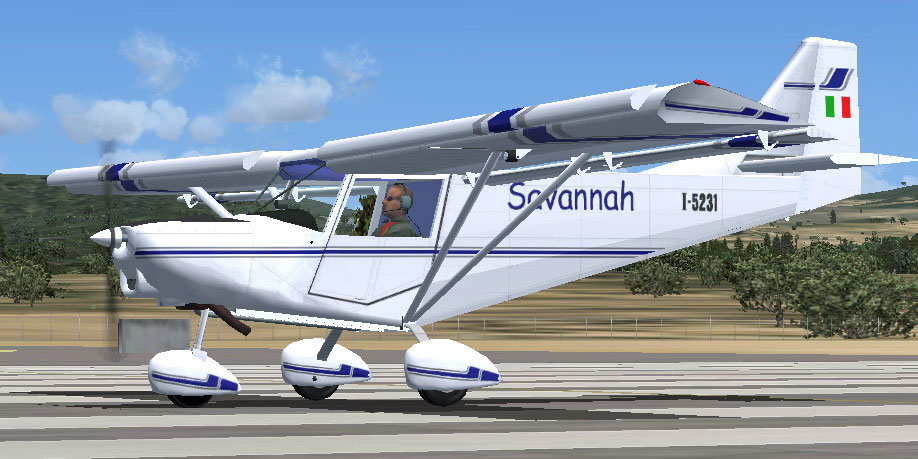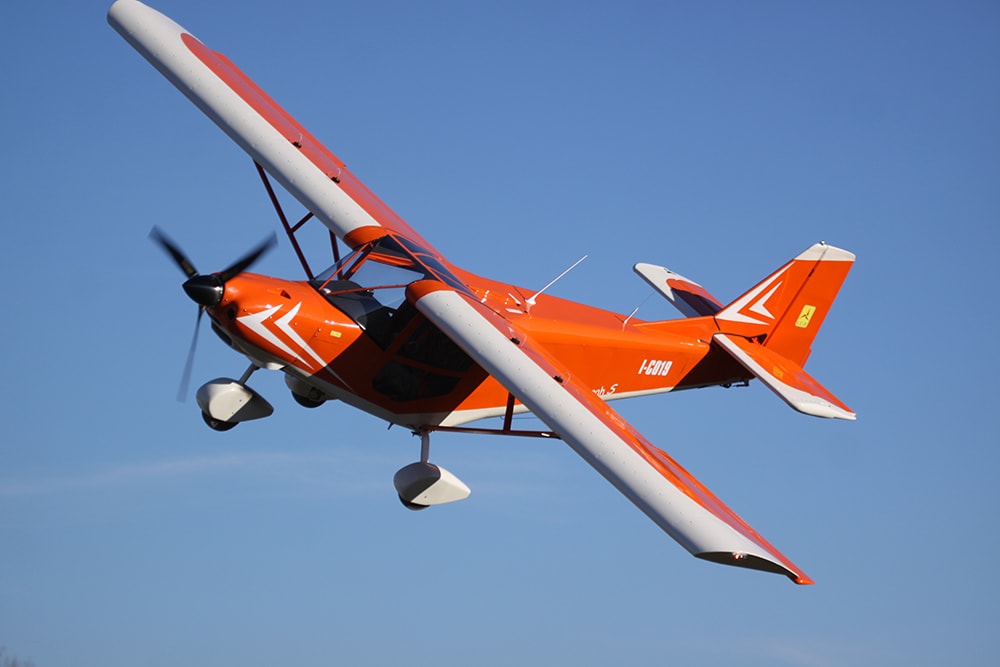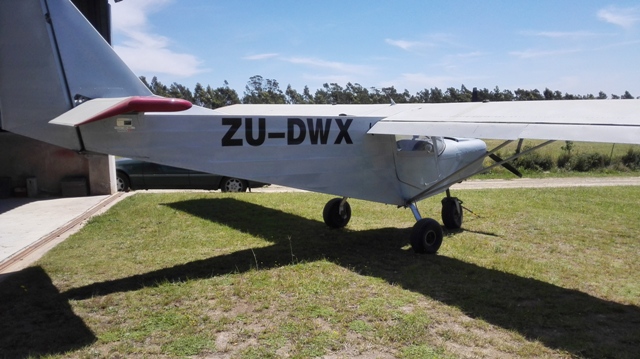As we have three 701s and three Savannahs at our airfield, we’re in a good position to compare the two aircraft. We fly them really intensively, especially practicing STOL Ops and out-field landings, as well as considerable cross-country cruising in company, so we can compare performance directly. We assembled two Savannahs in my workshop, and all three 701s have had extensive rebuilds here (one of them was purchased as an insurance write-off, and another had suffered extensive damage before we bought it), so we know their construction very well – a whole lot of rivet stems been on this floor.....
Hans now has about 900hrs flying time on the 701, and I have 900 on the Savannah that we’ve used for most of the direct comparisons. Both are equipped with Rotax 912S, 100hp, and are very similar all up weights. We’re experimenters at heart, so we’ve also gone on to remove the slats from both of them, and extend the wings on the 701, so that adds to our experience with these aircraft.
On the market you have a choice of the Savannah ‘VG’ model, or the standard CH701 with short wing and slats, but I’ll also include comments on our modified 701 with longer wing and VGs instead of slats, just to widen the perspective.
Final Environmental Assessment for E-2/C-2 Field Carrier Landing Practice Operations at Emporia-Greensville Regional Airport, Greensville County, Virginia, and National Aeronautics and Space Administration Wallops Flight Facility, Accomack County, Virginia.
Of course, the first criticism of this comparison from 701 enthusiasts will be that the 701 slats probably weren’t built and installed exactly as required. Well, I must point out that Hans, the builder of the 701 that we have used for most of the testing, is a dedicated and experienced craftsman, ex Royal Dutch Air Force crew chief, and he built his 701 from a kit exactly as specified.
Trying not to be biased here – just laying out the differences in design and construction, and analysing the effects that those differences make to real life performance. There’s lessons to be learned here, both ways.......
Design and Construction
The ICP Savannah S has the latest technology and the intergrating of all improvements introduced by the world renowned Savannah aircraft. The sporty controls, superior handling and super STOL performance allows you to fly to any destination, and more importantly, fly out of the shortest runways. The ICP Savannah S has the latest technology and the intergrating of all improvements introduced by the world renowned Savannah aircraft. The sporty controls, superior handling and super STOL performance allows you to fly to any destination, and more importantly, fly out of the shortest runways. The Ventura-4 is the latest in a prestigious series of aircrafts and is the result of extensive studies by the ICP R&D department aimed at satisfying the growing market demand for a larger aircraft with more space and a larger load capacity. All metal construction. Of the Flight Control Display System with which the EC 135 and BK117 C-2helicopterscanbeequipped.Ithasbeenpreparedwiththe aid of the information contained in the the respective flight manuals and maintenance manuals. The information contained in this training document represents the technical status of March 2006.
Wing
The most significant difference that you see immediately is the cutaway over the cabin of the 701, whereas the Savannah wing carries straight through. The Savannah wing is also 2.6 ft longer overall span. Profile and thickness of the wings are identical. There have been a couple of significant upgrades on spar and strut attachments – the ‘SP’ mod on the 701, and the 560kg upgrade on the Savannah.
The flaperons are the same. Neither aircraft has washout in the wing, but there is an offset between the inner and outer ailerons, which is very effective to produce the same effect as washout.
The slats were the same, but now I.C.P. Savannah has relaced the slats with a ‘VG’ version with leading edge extended 66mm forward, and VGs instead of slats.
Another significant difference is that the 701 has 75mm dihedral, while the Savannah has none.
Fuselage
The Savannah main wing spar to fuselage attachment is at the top of the spar, while the 701 is at the bottom, so the welded framework over the cockpit is different, and different strengthening on the inboard ends of the spars. This makes for more headroom in the Savannah, but a steeper windscreen. Other than that, the fuselages are pretty much identical.
Tail
The tail of the Savannah is quite different from the 701. Most obvious is the fixed vertical stabilizer and attached rudder, while the 701 uses that distinctive all-flying rudder. The horizontal stabilizer on the Savannah is symmetrical, rather than that distinctive inverted airfoil on the 701. It’s also 230 mm more span than the 701 stab due to the moulded plastic tips. The Savannah elevator is 60 mm longer (front to trailing edge).

Landing Gear
The landing gear is very much the same. The 701 has Matco brakes, which are excellent. The Savannah brakes are adequate, if they have the correct compound in the pads – some early models had a compound that was very abrasive and poor friction....
Kits
The Savannah kit is very well detailed, and all the CNC made parts fit amazingly well. Only a few extrusions that have been drilled by hand are annoyingly half a hole off... The instructions are pathetic, and it’s not just language translation, they’re poorly compiled. Lots of rivets need to be drilled out later because the instructions didn’t warn to leave them open until fitted up to something else later.... There’s a great opportunity here for someone to make a good DVD showing the process in better detail. Despite all that, a first time builder here logged 400hrs to completion, ready to fly – but he’s a speedy worker in whatever he does.
Hans’s 701 kit was from 7 years ago and took him pretty close to 1000hrs. I understand that present 701 kits have more parts pre-drilled....
The very best aspect of the CH701 is that it can be built from plans and stock materials very economically. The simple design and construction uses these stock materials very well. The plans are pretty good, a third-party DVD give much more detail, and there’s lots of support on the web from other builders.
Performance
The longer wing on the Savannah really shows up in the difference in glide ratios.
7:1 for the Savannah and 4.9:1 for the 701, both with slats.
Now I.C.P. has replaced the slats with VGs and the G/R is up to 8:1 @ 45kts.
At 40 kts the Savannah glides really well, while the 701 with slats is falling rapidly at +800fpm, and not much control...... Even at 35kts, engine off, the Savannah still has a good controllable glide – can’t do that at all in the original 701.
Those glide figures are all at power off prop stopped between 3000 and 2000 ft QNH, 22-25ºC., with approx. 380kg (840lb) weight. Not many flyers or manufacturers quote glide figures with prop stopped, but we’ve found that it’s the only way to get dependable comparisons – variations in idle speed make too much difference for comparisons. (I.C.P.’s listing in my assembly manual of a G/R of 12:1 for the Savannah with slats would be possible only with a lot of help from the prop!) But if the engine does stop some day and you have to do a dead-stick landing, it will be the real flying characteristics that you will have to deal with........
The end result of all these figures is that the Savannah lands much slower and more gently, with more control at idle power, just what you need for STOL Ops. The actual G/R (ie- lift/drag ratio) at landing speed will determine how gentle is that critical transition from flare to touch-down. The increased lift of the longer wing, and lack of drag from slats, make that transition far more gentle and forgiving in the Savannah. Once in ground effect, the Savannah actually tends to float on and on – the 701 never did that....
The 701 with slats needs to be flown with power all the way, right to touch-down, to overcome the rapidly increasing drag from the slats as the AoA increases. That’s a handy technique to easily judge spot landings – just pull the power and it’ll sit down right now, no floating on. Just be sure you’re right close to the ground when you do pull the power..... That power is also essential to get enough elevator control to hold the high AoA necessary for the slats to be effective.
The 701 works well when landed that way, and many pilots prefer to ‘fly with the throttle’.
Of course the Savannah can be flown on with power as well, just needs less power due to less drag, but tends to float on farther than expected once the power is cut. I much prefer to fly a glide approach at idle power all the way from base leg, and maybe just a trickle of power late in the flare to hold off for that really slow, gentle touch-down – it’s a great feeling!!!
The Savannah may look like a copy of the 701, but with the changes made they fly quite differently when it comes to both landings and cruise. The early Savannah with slats had similar drag characteristics as the 701, but much more lift due to the larger wing area, so touched down at a considerably slower speed.
Quoting actual stall and landing speeds is fairly irrelevant, since the ASI readings are subject to gross error at these speeds and AoA, and GPS has an ‘averaging lag’ so not suitable for instantaneous readout of varying speed. Shouldn’t be looking at the instruments anyhow at this point – should be judging from the outside visuals and control feel.....
I haven’t measured landing distances, but do have a very good real life comparison. At our home airfield, the runway has a taxiway entrance 50 metres from the threshold. The runway is quite downhill at this point, and the surface is grass and loose dirt, so braking traction is poor. I’ve always been able to land my Savannah in this area and turn off to the taxiway. In his original 701, Hans tried and tried to be able to do that but just couldn’t, much to his annoyance....... Now that he’s extended his wings he can do it as well, and is very satisfied!
Due to that larger wing again, the Savannah lifts-off shorter than the 701. The 15º flaps seem to be much more effective on the Savannah. (Hans has also found that the flaps on his 701 are more effective since he removed his slats.)
Climb rate and angle of climb of the 701 is less, due to all the drag from the slats and the higher induced drag with that short (lower aspect ratio) wing. A lot of the potential climb power is lost due to all that drag......
At cruise of 5000rpm the Savannah is 6kts faster (82kts) than the standard 701 (76kts). However, the 701 short wing without slats got 83kts, and long wing w/o slats 82kts.......
Fuel consumption is more difficult to compare accurately due to different props. At 75kts economy cruise over a 50hr cross-country trip, the original 701 with slats, used 17 litres/hr (4.5gal/hr), while the Savannah without slats used 13 litres/hr (3.4 gal/hr). That's 25% more with the slats, and makes a heck of a difference for fuel planning on long flights...... On a more recent 38 hr trip at 80kts, the 701 with long wing and VGs, and the Savannah, both used 16.4 litres/hr (4.3gal/hr).
The difference in horizontal stabilizers is really interesting. That unique horizontal stabilizer with its inverted airfoil on the 701 looks great in theory, and works well enough with power on, but can’t flare to a high AoA at idle power. This is a problem that has plagued 701 flyers for a long time...... There is a fix for this lack of elevator authority on the 701 – see ‘Tail Feathers’ page. With its symmetrical horizontal stab and the larger elevator, the Savannah can pull a high AoA even in a power-off situation.
That all-flying rudder on the 701 is very powerful at all speeds – great for magnificent slips and balancing the wing at ‘mush’ speed. With all that dihedral, that rudder is needed in all turns. The Savannah pretty much loses all rudder effect at 30 kts idle power – fortunately the ailerons are effective at any speed and bring very little adverse drag. But there are times that I would like to have that all-flying rudder on my Savannah for those slow manoeuvres and strong x-winds..... At cruise the lateral stability of the 701 is quite adequate, but in the Savannah it’s excellent – I regularly cruise for many hours at a time without touching the stick – just a bit of rudder and the electric trim.....
Those all-flying flaperons on both aircraft are really excellent! They give very positive roll control, without adverse yaw, right down to minimum flying speeds. At 15º flap extension they give more lift with very little extra drag, and really steady the aircraft at low speed. Neither aircraft tends to stall a wingtip, due to the ‘washout effect’ from those offset ailerons. They really do work well!
Much is made of the engineering superiority of the 701, and casting doubts on the engineering of the Savannah. I’m not qualified to assess that aspect technically, but they both seem to me to be very robust aircraft. Lots of Savannahs flying for 1000s of hours already, and in some pretty rough conditions, with no problems. That failure with a Savannah in Norway is very much over-blown. Even a 701 tied down such that it had those very high loads jerking sideways on the strut fittings could have caused flexing, and then to have forcefully straightened such a high-stressed aluminum fitting after it had been bent is asking for failure....
The Savannah VG is about equal in STOL, and heck of a lot better in cruise!
But with the longer wing on the 701, and VGs instead of slats, they are pretty much equal.
'Jeep' Analagy
I reckon that a good analagy with vehicles, is that the 701 is like an original Willys WW2 Jeep, while the Savannah is a more recent Suzuki 4wd. The Jeep was the inspiration, but Suzuki has considerably improved it. I've had a fair bit of experience with both vehicles, and find that the Suzuki 4wd is better off-road, and very much better on the road than the Willys. Just as the Savannah is a bit better at STOL and very much better at cruise.
See also:
Fun Fly Aerosports are proud to supply and support the ICP Ventura and ICP Savannah S Aircraft.
These are available from us as Ready-to-Fly or Kit Aircraft.
We are the sole agent for ICP srl, the Italian manufacturer of these superb aircraft.
The ICP Savannah S is available as either a factory built aircraft or as a kit.
The Savannah S can be configured as a 450kg Microlight or 600kg Group A Aircraft
The Ventura is supplied as a 600Kg, 750Kg or 800kg Max Gross Weight Group A aircraft kit.
We have the expertise to provide a bespoke builder-assist program for either aircraft.
Icp Savannah Flight Manual Pdf
Ready To Fly Or Kit Aircraft for the Savannah S Microlight and Ventura Group A aircraft
Icp Savannah Flight Manual
Ready To Fly
Precision Built , Pilot Tested , Quality Controlled.


Available Kits
Both Models are available as a kit option for home building.
Kit Build Assistance
We have a number of Service Packages to help you with your Kit Build.
Want to Sell Your Used Aeroplane?
We have a strong community of Flying enthusiasts. If you are interested in staying in touch or finding out more about getting started or selling your own plane, send us on your details below .
If you would like a brochure on any of our models please request .
Icp Savannah Flight Manuals
Tel 087 6617115
Icp Savannah Flight Manual Download
Open Hours
Icp Savannah Flight Manual Online
Mon:10am – 5pm
Tue: 10am – 5pm
Wed: Closed
Thur: 10am – 5pm
Fri: 10am – 3pm
Sat: 10am – 3pm
Sun: 10am – 9pm
Send A Message


